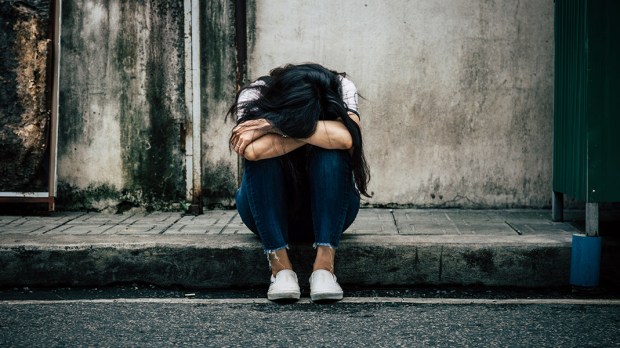While it’s newsworthy that a government report shows suicides in the United States as being up by 3% – reaching a record high – for a Washington-based researcher the more astounding figure is that over 16 million Americans seriously considered ending their lives last year.
“The thing that I tend to emphasize even more [than the number of suicides] is that there are 16,600,000 Americans – adults and teens – who report serious thoughts of suicide,” said David A. Jobes, director of the Suicide Prevention Laboratory at The Catholic University of America. “That’s a massive number of people. That’s over 300 times greater than people that die of suicide. To me as a clinician, as a researcher, it’s a really compelling number. That’s a lot of suffering souls.”
Even during 2019-2020, the first time in decades that there was a decline in the rates of suicide in the US, there was still “a steady march upwards of serious thoughts of suicide,” Jobes told Aleteia.
Highest number in history
Both figures – the government report of a 3% increase in suicides and the 16.6 million people who gave serious consideration to taking their lives – are based on statistics from 2022, the latest year they are available. The report – from the National Center for Health Statistics – is provisional, awaiting a final accounting, particularly from cases where cause of death has not yet definitively been ruled as suicide.
Nevertheless, Jobes said, “It would be the highest number that we’ve seen in the nation’s history, I believe, over recent years.”
The National Center for Health Statistics estimates there were 49,449 suicides in 2022. That’s 3% higher than the final 2021 number – 48,183. The number of suicides for males increased 2%, from 38,358 in 2021 to 39,255 in 2022, while the number for females increased 4%, from 9,825 to 10,194.
Rates for people in age groups 10-14, 15-24, and 25-34 declined 18%, 9%, and 2%, respectively, from 2021 to 2022.
In contrast, rates increased 3%-9% for all age groups 35 and older, with significant increases for those ages 35-44 (from 18.1 to 18.7), 45-54 (18.2 to 19.2), 55-64 (17.0 to 18.5), and 75 and older (20.3 to 21.3).
“Consistent with 2021, the rate for people ages 10-14 was the lowest of all age groups in 2022, while the rate for people 75 and older was the highest,” said the report.
American Indians and Alaska Natives
Of the five race and Hispanic-origin groups presented in the report, the highest age-adjusted rate in 2022 was for American Indian and Alaska Native non-Hispanic people at 26.7 deaths per 100,000 standard population.
All other race and Hispanic-origin groups experienced increases of 1%-3%, with a 1% increase for White non-Hispanic people (from 17.4 to 17.6) and a 3% increase for Hispanic (7.9 to 8.1), Asian non-Hispanic (6.8 to 7.0), and Black non-Hispanic (from 8.7 to 9.0) people.
Rates for men in all age groups 35 and older increased from 2021 to 2022, with significant increases for those ages 55-64 (10%, 26.6 to 29.3) and 45-54 (6%, 27.7 to 29.5). Consistent with 2021, the highest suicide rate for males was for age group 75 and older, whose rate increased nonsignificantly from 42.2 in 2021 to 43.7 in 2022.
For females, rates declined for those ages 10-14 and 15-24, with a significant 22% decline only for those 10-14 (from 2.3 to 1.8). Rates increased 7% for women ages 25-34 (from 7.3 to 7.8), the only age group with a significant increase. Rates also increased 2%-9% for women in age groups 35-44, 45-54, 55-64, 65-74, and 75 and older.
“The provisional 2022 suicide number (49,449) was 3% higher than the 2021 final number (48,183), and the highest number ever recorded in the United States,” the report summed up. “The 2022 final number of suicides is likely to be higher as additional death certificates with pending causes of death may be determined to be suicides.”
Causes and a solution
Jobes, who is a professor of psychology and associate director of clinical training at CUA, was hesitant to identify causes for the increase, but noted that there have been significant increases in depression, anxiety, and substance abuse.
“Opioid deaths are at record numbers – probably disguising the actual number of suicides as certified as overdose by accident,” he told Aleteia. “So the actual number of intentional deaths may be greater than the ones that are officially reported.” He said there could also be economic reasons, as well as unemployment and the continuing impact of COVID-19.
But, he said, “I would contend that we’ve got a busted mental healthcare system. Most people think that effective treatment for a person who is suicidal is hospitalization – which tends to be very brief – or medication. Neither of those interventions have much empirical support and sometimes they make things worse. And there’s a handful of interventions like the one developed by my lab at Catholic that are highly effective for treating ideation behaviors, but they’re not widely used.”
A method of treatment
He said that his method — the Collaborative Assessment and Management of Suicidality (CAMS) – is effective in reducing suicidal ideation, hopelessness, and overall “symptom distress.”
“One could argue that if you’re better at identifying people who have serious thoughts of suicide, we have fewer attempts and fewer deaths downstream,” Jobes speculated. “But the field tends to be very focused on behavior and not as much on the suffering.”
However, he said, it’s been an “uphill battle” to get the method to those who would benefit. “Clinicians are overly preoccupied with liability and they’re afraid of being sued for malpractice if there’s a tragic outcome, so they end up doing these better-safe-than-sorry approaches which involve hospitalization and medicating patients in ways that are actually not therapeutic,” he said.
He called his method “a patient centered, collaborative approach where we listen to the patient. They describe the nature of their struggle. We try to keep them out of the hospital – we’re very explicit about trying to keep them out of the hospital – and then the big thing is that we ask them to start using a stabilization plan so we can keep them out of the hospital and they can get through difficult times. And this may sound silly but the the main sort of thrust to the intervention is to ask the patient ‘What makes you want to kill yourself?’”
Research reveals that the vast majority of suicidal people are suicidal over relationship issues, “so we can bring their spouse in for couples therapy or we can try to connect to their kids if they’ve been disconnected with their kids, if their kids no longer talk to them – whatever the relational conflict is, we try to treat that,” Jobes explained.
As well, “there are issues with the self – people that we see have sometimes intense self hatred. And so we have interventions that treat these drivers, and what the patient experiences is being heard and validated and having the things that make them consider suicide actually being addressed and treated within the course of their care. In six to eight sessions we can drop the ideation very quickly; overall symptoms distress comes down, and we can actually move towards consideration of a life worth living.”
Jobes is encouraged by the development of the new 988 number that people can call if they are feeling suicidal.
“That is clearly driving a lot of awareness about the need for alternatives to inpatient and emergency department care because those environments are very expensive and they don’t treat the problem very effectively,” he said. “It’s now a more accessible number, but we already had capacity issues before we had a number that anybody could remember, and now that it’s easier to remember there’s been a 40% increase in calls to the lifeline and there aren’t enough volunteers to really service that increase.”



